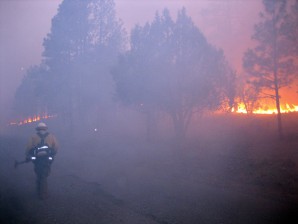ALBUQUERQUE, New Mexico — The more than 1,200 firefighters who are battling the nation’s largest wildfire in the rugged mountains and canyons of southwestern New Mexico were racing Saturday to build lines to corral the massive blaze before more threatening winds and dry conditions developed.

In this Tuesday, May 29, 2012 photo provided by the U.S. Forest Service, a firefighter walks along a burn out line as part of an effort to contain the nation's largest wildfire in the Gila National Forest in New Mexico. More than 1,200 firefighters are battling the blaze that has charred 340 square miles, or 218,000 acres, of terrain in the rugged mountains and canyons of southwestern New Mexico. AP/U.S. FOREST SERVICE, MARK PATER
The fire had charred more than 354 square miles (917 square kilometers) of the Gila National Forest by Saturday morning, and fire managers expected it to start backing down the mountains east of the community of Glenwood.
While there was no immediate threat, residents there have been immersed in a thick haze of smoke for days. At night, the ridgeline in the distance lights up with flames.
Fire information officer Lee Bentley said some of the crews that have been burning out vegetation ahead of the fire will be repositioned to keep it from getting any closer to the community.
“We’re going to continue fighting this fire aggressively without putting our firefighters in danger,” he said. “We’re getting as much of a black line as we can around this fire.”
Fire behavior was expected to be active to extreme on Saturday with wind gusts of up to 28 mph (45 kph). Humidity levels also remained low, Bentley said.
The fire is about 15 percent contained, with much of that being on the fire’s northern and northwestern flanks.
The blaze in the Gila National Forest — the largest on record in New Mexico as well as the country’s biggest current blaze — has burned through 227,000 acres (91,865 hectares) of rugged terrain. So far, it has destroyed a dozen cabins and eight outbuildings.
It’s too early for the ecologists, soil scientists and hydrologists to get on the ground to start assessing the fire’s effects, but they are hopeful much of the area can recover given that only a portion of the fire has burned with the kind of intensity that can vaporize entire stands of trees and damage the soil.
Another factor in the fire’s behavior is the Gila forest’s decades-old strategy of allowing lightning-sparked fires to play more of their natural role in cleaning up the forest’s litter. Fires within the Gila Wilderness are often managed rather than immediately extinguished.
The Whitewater-Baldy fire has already run into previously burned areas, which fire managers say have helped slow the flames.
Montoya said the rugged terrain has forced firefighters to attack the flames indirectly by starving the fire of fuels along its perimeter.